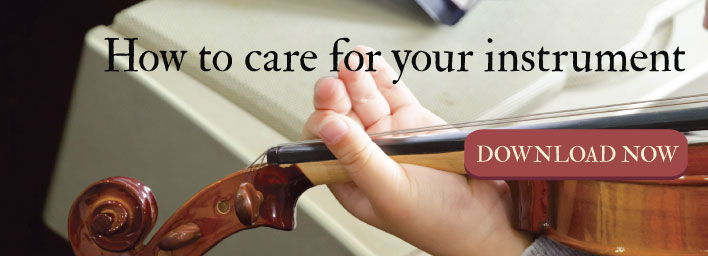How to Polish Your String Instrument

If you’re new to learning the violin, or you’ve been playing for a while, you’ve probably noticed that eventually your violin loses a little bit of its lustrous shine. Oils from your hands and fingers, rosin dust, and other factors can combine to create a dirty build up on your instrument. Since you want to keep it in top playing condition, you should know the proper methods for cleaning and polishing your violin. Although it’s not too difficult to learn those tasks, understanding the best methods is important so you don’t inadvertently damage your instrument or effect its tone or sound production. The following how-to’s can help.
Firstly, always wipe down your violin after playing or practicing. Using a small soft, or microfiber cloth (approx. $3) gently wipe off the strings and body of your instrument to remove rosin and oils each time you play. Choose a material that is lint free for the best results. This is the primary and best method for keeping your violin in top condition, but if you neglect it, eventually you’ll need to extend the cleaning process to ensure that all the dirt and particles are removed before you attempt to polish your violin.
Cleaning Your Violin
There are many different views on what is the best way to remove residues from your violin. Cleaners that have silicone oils, lemon juice, or high alcohol concentrates can damage your instrument, so choosing the best material can be tricky. One of the surest methods of finding a good cleaner is to speak with your local violin dealer; a shop that has a luthier (string instrument maker and repairer) available on staff. He or she will be able to suggest a specialized cleaner to use. If for any reason you aren’t sure about it, it’s always best to have the shop perform the cleaning.
Hill Violin Cleaner and Polish is a popular cleaning product, but you can also choose the organic method. Hold your instrument close to your mouth and breathe on the surface. Then gently rub the area, using your cloth, in small circular motions. Interestingly, the moisture in your breath provides just the right amount of dampness—not too much or too little—and it leaves the surface shiny. Likewise, your all-natural saliva is another excellent cleaning solution. Apply a very, very small amount to dirty areas and wipe off using the same method as with the breathing technique. For some reason, it loosens and removes the residues that adhere to the surface of your violin better than commercial cleaners.
Xylene (available at your local hardware store) is another solvent that can be used to remove large rosin deposits on your violin. However, it is a very dangerous substance and should never be used lightly or within closed spaces. The fumes are toxic and it should not make contact with your skin. It also has the power to strip the varnish right off your violin, so unless you’ve been instructed in this method by a luthier, it’s best to avoid it.
Polishing Your Violin
Now that your instrument is well cleaned, you can polish the surface so that it really shines. Quality violins typically have an outer layer of varnish in addition to the original varnish, and if the breathing technique doesn’t provide the luster you’re looking for, you can use a special violin polish. Add a very small drop of the polish to a clean, lint-free cloth and rub it on your instrument using small concentric circles, about 5-6 cm in diameter.
Never, ever use household wood polish on your violin. They can leave deposits that negatively impact the sound of your instrument.
Although you can use a French alcohol or French Polish technique at home, it’s better to have a professional polish your violin with these techniques if you aren’t 100% sure that you can do it correctly.
The French alcohol polish method involves using mineral oil and ethyl alcohol. Using your small lint-free cloth, folded into a square, apply enough alcohol to make it damp, but not dripping wet. Then apply one or two drops of mineral oil to the center of the pad. The alcohol is going to soften the outer layer of varnish, so you’ve got to be sure to keep the pad moving in circles over the small area. However, if you stay in the same area too long, the oil can build up, which will also cause problems. Therefore, the best way to polish your instrument is to use your own breath, or have a luthier perform it.
Keeping your violin clean and looking great really just requires regular wiping. That way you ensure that rosin, dirt, and oils are removed, and you’ll be able to polish your violin the natural way.


